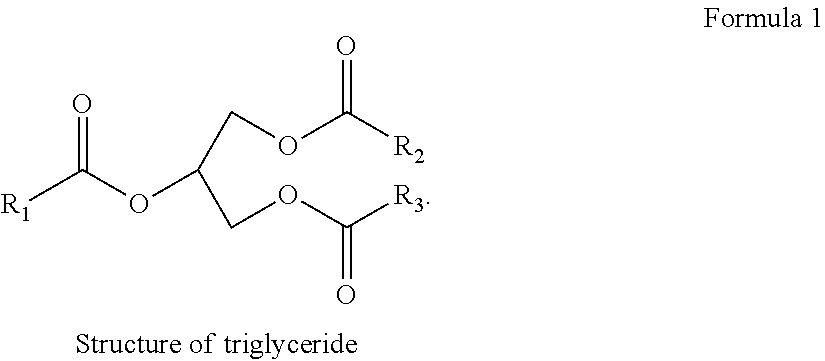Deoxygenation of materials of biological origin
a biological origin and deoxygenation technology, applied in the direction of hydrocarbon oil treatment products, organic compounds/hydrides/coordination complex catalysts, physical/chemical process catalysts, etc., can solve the problems of poor stability, and limited use of transportation fuels in regions with colder climatic conditions
- Summary
- Abstract
- Description
- Claims
- Application Information
AI Technical Summary
Benefits of technology
Problems solved by technology
Method used
Image
Examples
example 1
Deoxygenation of Stearic Acid
[0095]Deoxygenation of stearic acid (purity 95%) (reactant) was performed in a Parr reactor with ruthenium carbonyl catalyst. Before the reaction, the reactor was loaded with 5.3 g of Ru3(CO)12 catalyst, 24 g of stearic acid, and 4.5 g of water and 0.33 g of sodium hydroxide, the molar ratio of water to NaOH being 30. After the loading of the reactant, the reactor was pressurized to 80 bar of nitrogen for studying the tightness of the system. Then the reactor was depressurised and filled with carbon monoxide to an initial pressure of 30 bar, rising to 70 bar at reaction temperature of 250° C., the reaction time being 24 h. The conversion was 72%. The results are presented in the following as % by volume:
[0096]
n-C17 paraffins53.6%Total paraffins61.6%Total hydrocarbons69.9%Total esters2.5%Stearic acid27.7%
example 2
Deoxygenation of Palm Oil
[0097]Deoxygenation of 5 g of palm oil (reactant) was performed in a Parr reactor with 5.3 g of Ru3(CO)12 catalyst. Before the reaction, the reactor was loaded with the catalyst, reactant, 4.5 g of water and 0.33 g of sodium hydroxide. After the loading of the reactant, the reactor was pressurized to 80 bar of nitrogen for studying the tightness of the system. Then the reactor was depressurised and filled with carbon monoxide to a desired pressure initially of 30 bar, rising to 70 bar at reaction temperature of 250° C., the reaction time being 24 h. The results are presented in the following as % by volume:
[0098]
n-C15 paraffins8.5%n-C17 paraffins16.9%Total paraffins50.0%Total hydrocarbons52.3%Total esters1.2%Palmitic acid19.0%Stearic acid18.6%
example 3
Deoxygenation of Stearic Acid
[0099]Deoxygenation of stearic acid (purity 95%) (reactant) was performed in a Parr reactor with ruthenium carbonyl catalyst. Before the reaction, the reactor was loaded with 5.3 g of Ru3(CO)12 catalyst, 4.8 g of stearic acid, 4.5 g of water and 0.33 g of sodium hydroxide, the molar ratio of water to NaOH being 30. After the loading of the reactant, the reactor was pressurized to 80 bar of nitrogen for studying the tightness of the system. Then the reactor was depressurised and filled with carbon monoxide to an initial pressure of 30 bar, rising to 68 bar at reaction temperature of 250° C., the reaction time being 24 h. The results are presented in the following as % by volume:
[0100]
n-C17 paraffins41.3%Total paraffins70.5%Total hydrocarbons71.7%Total esters11.7%Stearic acid0.3%
PUM
| Property | Measurement | Unit |
|---|---|---|
| pressure | aaaaa | aaaaa |
| temperature | aaaaa | aaaaa |
| temperature | aaaaa | aaaaa |
Abstract
Description
Claims
Application Information
 Login to View More
Login to View More - R&D
- Intellectual Property
- Life Sciences
- Materials
- Tech Scout
- Unparalleled Data Quality
- Higher Quality Content
- 60% Fewer Hallucinations
Browse by: Latest US Patents, China's latest patents, Technical Efficacy Thesaurus, Application Domain, Technology Topic, Popular Technical Reports.
© 2025 PatSnap. All rights reserved.Legal|Privacy policy|Modern Slavery Act Transparency Statement|Sitemap|About US| Contact US: help@patsnap.com


